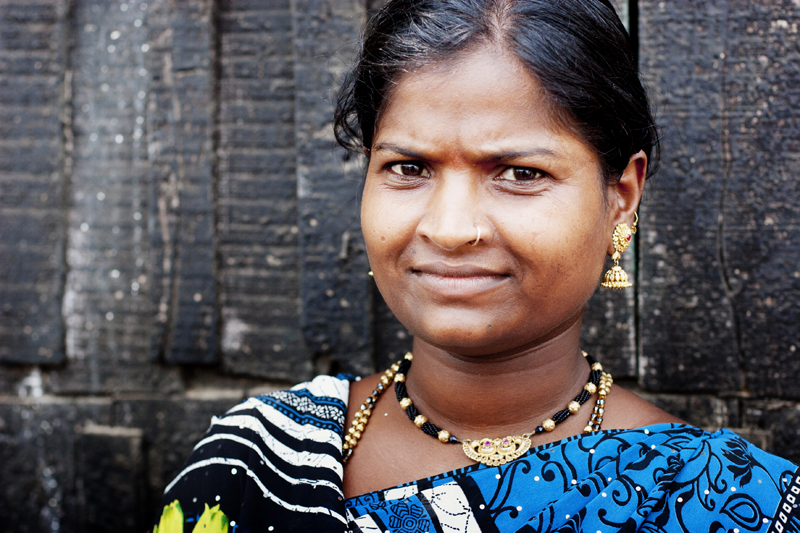A Tradition Misunderstood

Taking a beautiful country road from Dharwad, Karnataka, I reach the small temple village of Saundatti in South India. It is in this village that the devdasi tradition, one of the most criticized forms of prostitution in India, is still practiced. Best defined as “temple prostitutes,” devdasis are women who dedicate their lives to the temple deity. They are said to be the “Maids to God,” but they also serve as prostitutes for the priests and the rich members of the temple.
I was told that I might be able to meet a devdasi in the yatra (pilgrimage) taking place at the holy Matangi sarovar (lake). This lake is on the outskirts of Saundatti and during the yatra the devdasis take a “holy dip” before proceeding to the Renuka-Yellamma temple for prayers.
Traditionally, the devdasis performed duties at the temples and participated in religious functions in the villages. They were an integral part of most Hindu temples and were invited as honored guests to social functions in the villages to present dance and music. In fact, India owes much of its classical dance and music lineage to these women.
Bharatnatyam and Oddissi, two popular forms of Indian dances, are modified versions of traditional devdasi dances. MS Subbulakshmi, Lata Mangeshkar and Asha Bhonsle – three world-renowned Indian singers – trace their musical lineage to thedevdasi community.
Sadly, the devdasi tradition has degenerated over the ages and today the devdasis have been reduced to mere prostitutes. About a century ago, a campaign was launched to portray devdasis as immoral and many began to talk about abolishing the “evil” of the system. Historically, a devdasi’s life did not involve a denial of herself. She was free to have or refuse sex at her will. Once given to the temple, a devdasi devoted her life to the deity. Her sexual partner, generally an affluent person from the society, was chosen by her mother and the temple. The person who took on the girl as his dasi (maid) accepted responsibility for her social welfare.
In the 1980s, the Indian government banned the devdasi tradition and began working in tandem with various non-governmental organizations to help reinstate these women into the society, as well as raise public awareness of the demeaning nature of their life work. The government launched programs to “rehabilitate” the women, such as teaching them embroidery, knitting, tailoring and other skills to help them pursue an alternative livelihood. Despite the governmental ban, hundreds of girls are secretly dedicated to Goddess Yellamma every year. The devdasi system is still flourishing in parts of the country, especially southern India.
Though the temple I visited fervently denies upholding the devdasi practice, the locals assert the opposite. “The devdasis are still there, but the authorities won’t say so,” the flower seller outside the temple tells me. When I ask where I can find them, he tells me that the women live around the temple and locating them will not be easy. “But they are very much there,” he stresses in whispers. Rakesh, the shopkeeper of a little souvenir shop, says the same. “You won’t find them at the temple, but they are around,” he adds. He suggests that I visit the Matangi sarover.
If the flower seller and shopkeeper are correct, the modern devdasi practice holds little resemblance to the tradition practiced over a century ago. Instead of living in the temple premises, the women now live outside the temples in their own houses and take on the responsibilities of the temple work. Kamla, who takes care of the pilgrims’ shoes and slippers outside the temple, refuses to talk about the devdasis at all. When I ask another local about Kamla’s reluctance, she tells me that the people of the town have been strictly instructed by the temple authorities not to talk about devdasis to visitors. When they venture to do so, they speak in hushed voices.
I finally have the opportunity to meet a devdasi who is taking part in the yatra at the sarovar. Her name is Yellamma; in India, it is common to be named after gods and goddesses. After her “holy dip” in the lake, Yellamma proceeds towards the Saundatti temple. Draped in an off-white saari, with maed hair and a shell necklace around her neck, she tells me she dedicated herself to the deity at the Gedekal temple in Karnataka 22 years ago at the age of 12. She lived at Gedekal for 18 years, but for the last four years she has been at the Saundatti temple. She has four children, whom she is no longer in contact with, but she is informed that they are doing well and live in Bangalore.
Yellamma speaks only Kannada and it is difficult to communicate with her until a local woman offers help. Yellamma tells me that she can sing and dance well, yet has no formal education. She only takes one meal a day. She says devotion to God gives her energy and she doesn’t need food.
Born within a well-to-do family, Yellamma became a devdasi of her own will and says she is “content and has self-respect because she devoted her life to God.” Yellamma says she feels respected in the society and enjoys a special standing amongst women because of her devdasi status.
When I try to contact the temple authorities, they refuse to talk. However, after persistent requests, KS Yeduyariah, the head priest at the Renuka-Yellamma temple, agrees to meet with me. He speaks freely about the temple and its activities, but whenever I try to bring up the topic of devdasis, he avoids it. When I specifically ask if the temple supported devdasis, the priest angrily answers, “There are no devdasis in the temple. The government has totally banned the practice. If there are devdasis outside the temple, we don’t know. The temple has nothing to do with those women.” But the tension in his face reveals a different truth.
